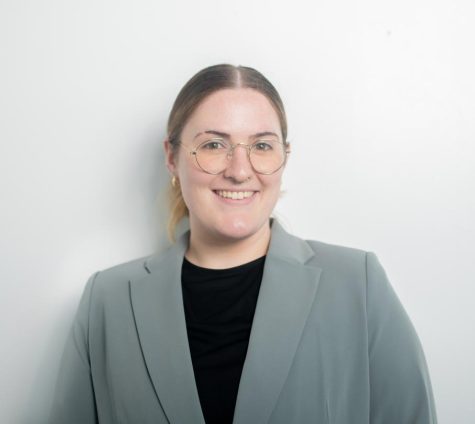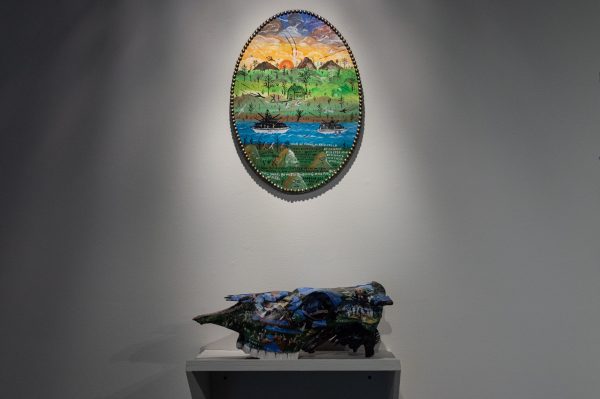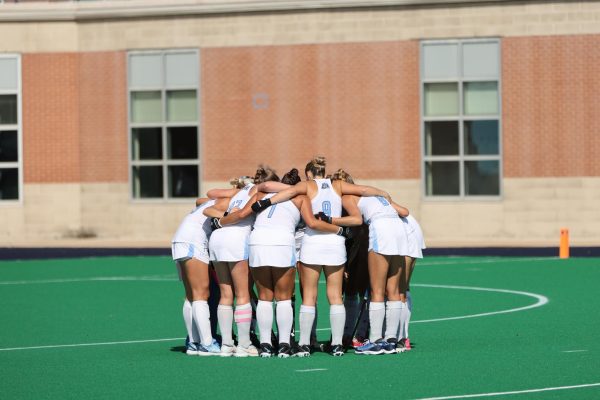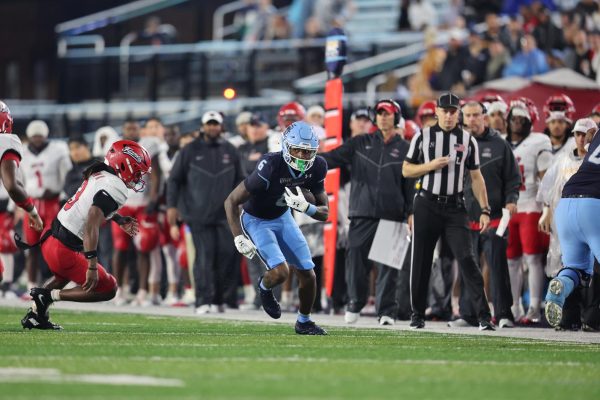The Principles of Design
ODU’s Graphic Design Students Recover After Two Full-Time Faculty Members Set out for “Greener Pastures”
Eric Ganci, founder of colores., is a student in ODU’s graphic design program.
This article first appeared in the fall 2022 Mace & Crown magazine issue.
Eric Ganci’s collection of dainty green bracelets reflects emerald light as he hands over a hot pink business card. The brand, a sole proprietorship offering a range of creative services, is called “colores.” and it’s run entirely by Ganci.
“There are actually different versions,” he explained, referring to the pink rhombus shapes occupying the front of the card. “That’s the second edition. The first was blue.”
Ganci is the president of ODU’s graphic design club and a senior in the major. He somehow strikes the balance between mild-mannered and talkative both in and out of class. He’s humble by nature, yet his subtle– and consciously made– style choices indicate what bubbles beneath the surface: he sports a gold chain, black gauges and a two-inch tattoo of a rose on his right hand, complimenting a tangle of loose bracelets. Anyone would assume he’s an artist, and they’d be right. A full-time student and freelance creative brand owner, he’s spent his entire undergraduate career establishing himself as a Hampton Roads creative.
Though neither his sense of style nor his experiences in the art department are by any means exclusive.
The summer of 2022 saw two of ODU’s full-time associate graphic design professors, married couple David Shields and Ivanete Blanco, flock to “greener pastures.”
“Being a professor, especially in graphic design, is a competitive field,” explained John Roth, associate professor and chair of the art department. “Somebody made them a great offer… [and] together they went to another school… Whenever faculty [members] leave the students who are in the process of their program, there’s an adjustment [period] – there’s no denying that.”
Shields taught communication design at Texas State University-San Marcos for twenty years before moving to Old Dominion University’s graphic design program in 2012. His resume showcases an array of impressive clients like Taco Bell, Sony Music Entertainment, Motorola, and even the Nickelodeon Network, denoting his mastery of the craft of design. But such wisdom is said to have been paired with a feeling of responsibility for his students’ professional success, at times limiting their range of creative freedom.
Shields was widely known for his narrow scope of what is “reasonable and justifiable in design,” Ganci recalled. “[He] had a very firm and limited direction… There was really no room to branch out and discover yourself as a designer. It was always practical, practical, practical; ‘This is what’s expected of you after college.’”
Blanco began her teaching career only eleven years after Shields, together accumulating a combined 49 years of teaching experience before their departure. Students remarked that she shared a similar militance, adhering to and enforcing the principles of design which accelerated both her and her husband’s career outside of the classroom.
Together, the two founded “R-N-R Showprint,” a collaborative letterpress and design studio based in Norfolk that earned international recognition for prints reflecting music, culture and social issues. Perhaps their decoration as established local designers is what enabled their rigidity on-campus, particularly in Shields’ course, GDES 371: Design Concepts.
“There should be a good balance of [principle] and creative freedom,” Ganci argued. “The real world isn’t all rainbows and sunshine… you still want to be prepared. You have to be able to take criticism and feedback. But [Design Concepts] really was make-it-or-break-it for a lot of people. They felt like their creativity was being stifled or challenged. It hardened some of us, and some of us decided it really wasn’t what we wanted to do.”
Graphic design currently stands as ODU’s largest major in the art department, with approximately 160 students enrolled. Though offered courses range from blacksmithing to printmaking to art history, design triumphs as the most practical, especially at a university geared towards convenience and accessibility. Despite the pandemic, Roth noted how the spring semester of 2022 brought students back with a bite, bursting with more passion and artistry than ever before.
“I could not believe how enthusiastic they all seemed to be,” he beamed. “I got some of the best work out of students in a long, long time.”
Noelle Jessup, a senior in the graphic design program, noted how both Shields and Blanco contributed to the strength of her work ethic around that time, despite their “limits on creative freedom.”
“The way that they taught was kind of militant,” she said. “The ‘cookie-cutter’ thing, for sure. But I think I benefitted from that because I really like structure and knowing exactly what is expected. At the same time, it does limit creative freedom. It was really hard to develop your own style… I liked them, but that came out of knowing that they know their stuff.”
Jessup and Ganci agreed that the sudden loss of both professors took a toll on most students in the program, regardless of personal experiences or interactions with them. Students flocked to one another in desperation and confusion when Blanco announced her official resignation over the summer.
“A couple of people compared it to mom and dad getting divorced and now they’re leaving us,” Jessup joked, her neon lightning-bolt earrings jingling against her jacket. “We have a group chat and everyone was kind of like ‘What are we gonna do?’ ‘Can we do anything?’ Some people, I think, scheduled zoom meetings to talk with them for the last time before they left. Definitely a period of time where it was like ‘Oh no, what’s gonna happen?’”
Visiting assistant professors Charilyn Colbert and Susan Matherene were ushered in as emergency hires, according to Roth, in anticipation of the fall 2022 semester. But graphic design students found themselves at the mercy of their only remaining professor, Kenneth Fitzgerald, for any updates regarding the situation.
“We were kept out of the loop,” said Ganci. “After they left, it was like ‘Shit, what are we gonna do now?’ There was a big scramble… We reached out to Kenneth Fitzgerald at the start of the summer, shortly after we found out… To my knowledge, their [Colbert and Matherene] workload is immense… [And] they’re still firm, but they’re open. They’ll allow you to go down your own path. They’ll still support you and try to give you options to further your own creations.”
For students like Ganci, the freedom to pursue their own design style is incredibly important to their professional success. Such prowess is precisely what both Fitzgerald and Roth hope to encourage within the department, particularly as the semester progresses and admissions outreach extends across the Eastern shore.
“I think what I’m getting from the art department is that there’s a lot of new energy,” said Roth. “We have two new hires here. I’m a new chair. And so new ideas are being addressed. Old ideas and old animosities are tamped down and I think the morale here is quite good.”

As for the students, mitigation looks like relearning how to trust one’s creative instincts.
“I feel like Iike I’m still going through that subtle shift of getting back to complete normalcy,” said Ganci. “There are some [people] that are still trying to piece themselves back together… I know a lot of people who just don’t have confidence in the work they do… having had those types of experiences in previous classes has made them undermine themselves.”
When asked about his hopes for the future of the graphic design program, he takes a minute to ponder. Jessup, notably, did the same. They mirror one another in more ways than one, both seemingly confident in their respective forms of eclectic expression.
“I hope all the people who come after me will find themselves creatively and not get bogged down on ‘Is this good enough?’” Ganci reflected. “As long as you’re proud of it, that is grounds enough for creating.”
Jessup continued as if directly addressing the fall 2023 incoming freshman.
“Just walk into it knowing that there is a larger community,” she said. “It’s not exclusive. I remember thinking it was going to be so hard, but it’s less scary than it is inviting.”

Dana Chesser (She/Her) is an English/Journalism major and second-semester writer for the Mace & Crown. Alongside her role as A&E Editor, she works...

Elena Harris is a speech pathology major and photography minor graduating in the spring of 2023. Outside of the Mace and Crown, Elena enjoys the ODU experience...










